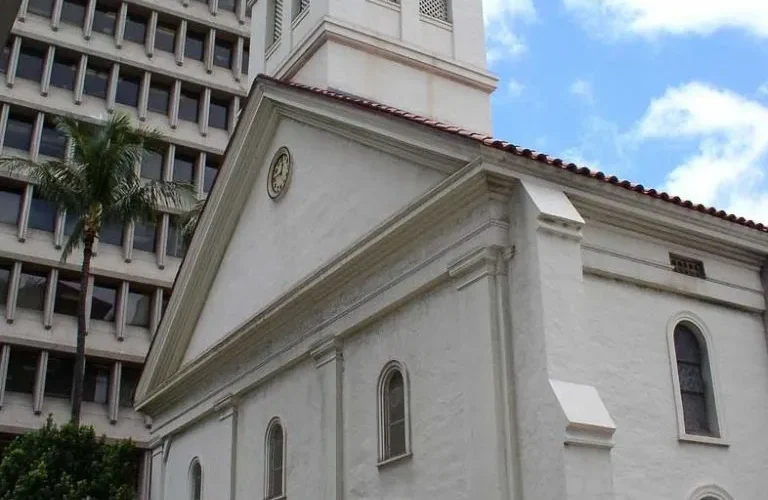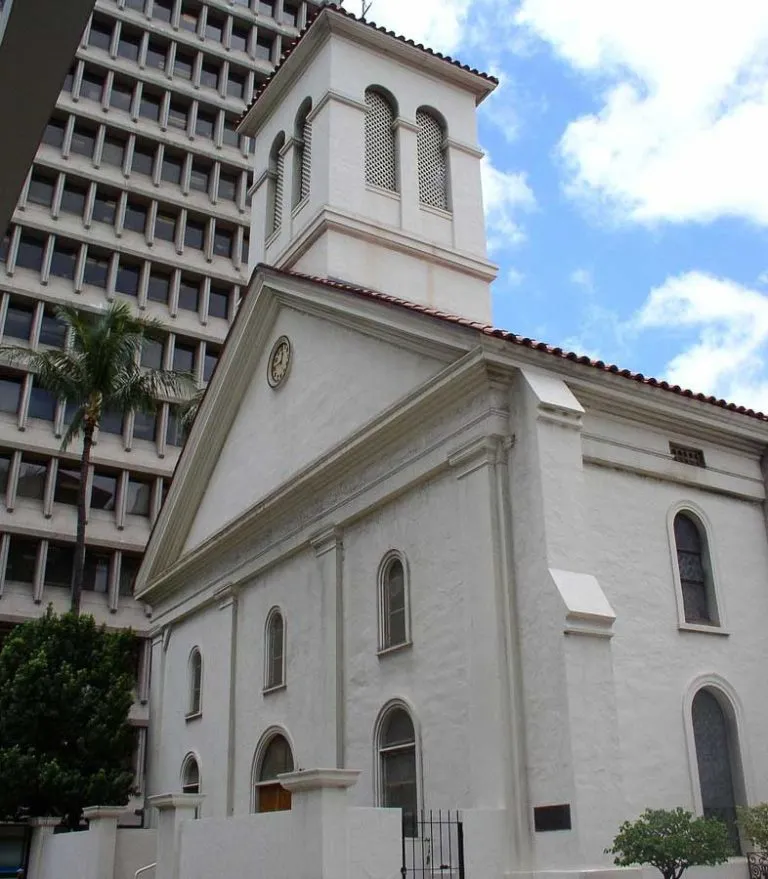
Introduction
The Cathedral Basilica of Our Lady of Peace, located in Downtown Honolulu, is the Mother Church of the Catholic Faithful in Hawaii.
The Cathedral Basilica of Our Lady of Peace dedicated on August 15, 1843, is the oldest Cathedral in continuous use as a cathedral in the United States and is the Mother Church of the Catholic Faithful in Hawaii. The Cathedral Basilica is listed on the National Register of Historic Places and is home to a first-class relic of St. Damien of Molokai and the full mortal remains of St. Marianne of Molokai. It also houses the oldest operating tower clock and one of the oldest pipe organs in Hawaii, and has a memorial of the first Kiawe (Algaroba) tree in the islands which stood on the church campus. Many come to the Cathedral Basilica for peace, serenity, and most importantly as a place to connect with God.
We, The Christian Faithful of the Cathedral Basilica of Our Lady of Peace mother church of the Roman Catholic Diocese of Honolulu, strengthen our community of faith as the center of liturgical celebration, Catholic religious education, stewardship, and outreach. We embrace the legacy of our rich history in moving to the future.
After some years of persecution of Roman Catholicism in the Hawaiian Islands (partly instigated by Congregationalist and Presbyterian missionaries who had befriended Kings Kamehameha II, Kamehameha III, and Kaahumanu, and partly arising from Hawaiian opposition to French influence), the Hawaiian government issued an Edict of Toleration creating freedom of religious expression. As an act of reconciliation, Kamehameha III gave the first Roman Catholic missionaries under the leadership of Apostolic Vicar Étienne Rouchouze a piece of the royal estate on which to build the first Roman Catholic church in the kingdom.
The missionaries broke ground for the new church on July 9, 1840. It coincided with the Feast of Our Lady of Peace Honolulu patroness of the Congregation of the Sacred Hearts of Jesus and Mary religious institute of which the missionaries were members. The missionaries gave that title to their first foundation in the new land. A Mass was celebrated on the day of ground breaking, when 280 native Hawaiians received the sacraments of baptism, confirmation, and first Eucharist.
The cornerstone of the building was ceremonially laid on August 6, 1840. Construction continued after ground breaking with native Hawaiian volunteers harvesting blocks of coral from the shores of Ala Moana, Kakaako, and Waikiki. Down the street, Congregationalist missionaries had earlier begun the construction of Kawaiahaʻo Church.
History of Our Lady of Peace, Honolulu
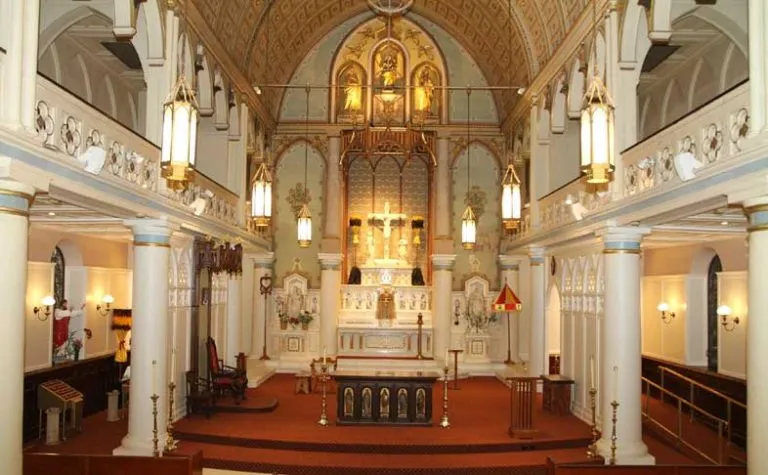
Nestled in between the shoulders of 400-foot tall skyscrapers lies Hawaii’s longest running Catholic cathedral preserved with features that date back to the reign of King Kamehameha III. The Cathedral Basilica of Our Lady of Peace is the mother church of the Diocese of Honolulu, home to the Bishop of Honolulu, and site where the two saints of Hawaii rest. Contained within the cathedral’s walls, which were made from coral blocks from the Kaka’ako shores, is a rich history that witnessed nearly 200 years of committed care to the land and community of the Hawaiian islands.
The First Catholic Parish
The first Catholic missionaries arrived in Hawaii on July 7, 1827. Among the group was Fr. Alexis Bachelot, who was the prefect apostolic and a member of the Congregation of the Sacred Hearts of Jesus and Mary.
Upon arrival, the missionaries were quick to integrate themselves with the island’s community. After learning the language, Fr. Bachelot and the other Catholic priests handed out bibles written in the Hawaiian language and held sacraments and baptism ceremonies for hundreds of the island’s natives. One year later, the Cathedral of Our Lady of Peace was built in the heart of what is now downtown Honolulu.
In 1831, King Kamehameha III, who was pressured by his Protestant advisors, enforced a policy that restricted the practice of Catholicism in the Hawaiian islands. Fr. Bachelot and the other Catholic priests were then expelled from the islands. It was until 1839 when the French frigate Artemise sailed into Honolulu Harbor and issued a manifesto demanding among other things, freedom of the Catholic religion in the Hawaiian Kingdom.
After settling back into Hawaii, catholic priests were able to formally dedicate the Cathedral on August 15, 1843. The anniversary, however, is observed on August 16 due to the Solemnity of the Assumption of the Blessed Virgin Mary into heaven being celebrated on August 15.
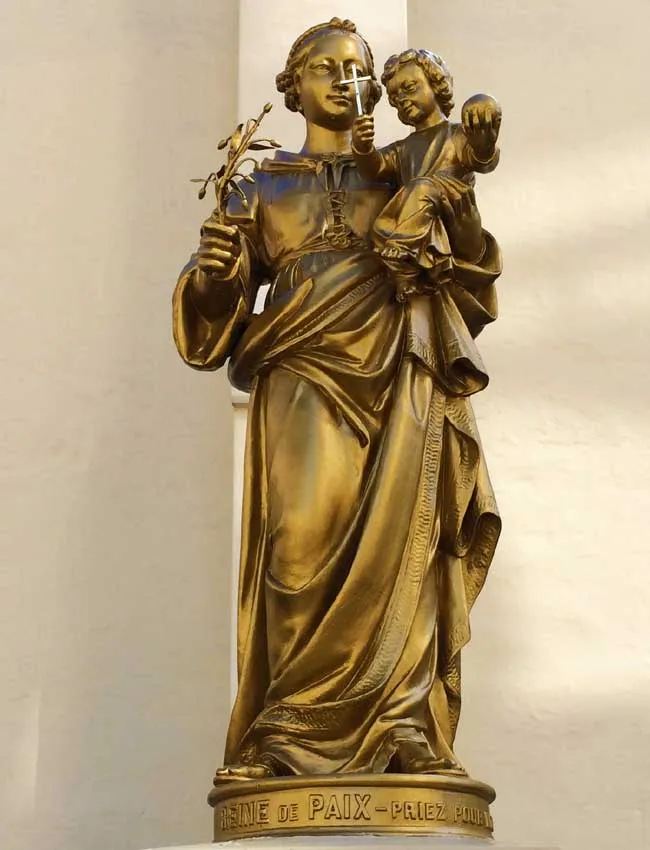
Cathedral Basilica Today
Today, the Cathedral Basilica continues to be a place of pilgrimage in Honolulu’s lively downtown district for the island’s Catholics. Though the cathedral’s surroundings have changed from jungles of wood and dirt to concrete and steel, many of the cathedral’s set pieces remain and are still in use.
The cathedral’s bell tower, which was constructed in 1917, is the oldest of its kind in Hawaii and each strike to the tower’s bell produces a lofty ring that roams through downtown’s busy streets. The organ, which was dedicated in 1934, is also the island’s oldest organ that is still in use and its rich, warm breaths fill the church giving an almost nostalgic feel for those visiting the cathedral.
Besides being a display of historical architecture the cathedral is also the resting grounds of the remains of St. Marianne Cope and a relic of St. Damien de Vuster. Within the cathedral is a shrine where churchgoers can pay their respects to these two figures who gave their lives to serve the Hawaiian community in God’s name.
The Cathedral Basilica of Our Lady of Peace continually seeks to provide the best for Hawaii’s Catholics while upholding the historical and cultural beauty of the church that had stood for multiple generations.
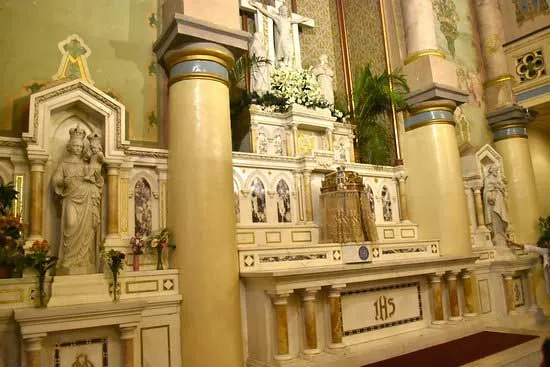
A Look Ahead
In 2016, the Cathedral of Our Lady of Peace launched a renewal campaign to address a number of needed repairs and revisions to aid in the preservation of the cathedral’s ethereal beauty and historical importance. The campaign sets out to build a new chapel to permanently preserve a state-recognized and nationally-recognized historic treasure, provide a more appropriate liturgical environment, strengthen and enhance its role in the downtown community, and honor Hawaiian culture and the evolving multicultural community with artistic detail and design elements.
Pipe Organ
The first pipe organ, installed shortly after the cathedral was built, came from France and had one manual and a pedal clavier. The second organ, installed in 1885, was built in England as the gift of parishioner Godfrey Rhodes, featuring great, swell, and pedal organs. The large statue of Saint Cecilia, patroness of sacred music, was placed on the casing in front of the organ in 1906. Because of wear, the Vicariate decided to move the 1885 instrument next door to the Columbus Welfare Building for use during choir rehearsal. A new instrument, the third and present one, consisting of great, swell, choir, and pedal organs was installed in the choir loft by organ-builder Alfred G. Tickner of the Aeolian-Skinner Organ Company of Boston. This instrument was solemnly blessed on September 9, 1934, by Msgr. Stephen Alencastre, followed by a dedicatory recital by organist Don George, broadcast over radio station KGU in Honolulu.
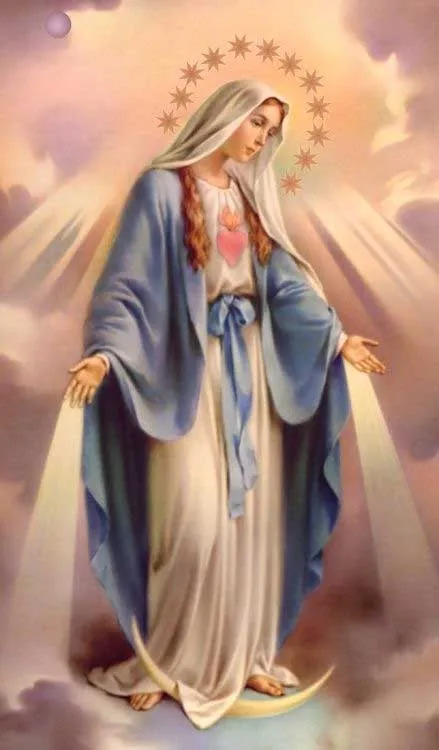
After the Second Vatican Council
Liturgically innovative ideas in the 1960s and 1970s took hold of some liturgists and theologians after the Second Vatican Council. These ideas, which claimed to follow the “spirit of the Council” rather than its actual texts, inaugurated controversial changes in some of the architectural standards of churches in dioceses worldwide. James Joseph Sweeney, first bishop of Honolulu and United States delegate to the ecumenical council that met in the Basilica of Saint Peter at the Vatican City, instituted renovations of the Cathedral Basilica of Our Lady of Peace, which some Catholics dubbed a “wreckovation” rather than a restoration.
Sweeney ordered the removal of the marble communion rails and installed a freestanding marble altar that faced the congregation, and reoriented the pews in a circular fashion around the altar. The canopied pulpit that was perched above the congregation was also removed in favor of a simple ambo and lectern from which the Gospels could be proclaimed and homilies and sermons could be delivered. The wooden cross atop the old altar was stripped and replaced with a sculptured marble crucifix. The ideology of that time encouraged churches to use native cultural implements in church architecture. Sweeney’s cathedral rector, Monsignor Charles Kekumano, installed koa wood wainscot along the walls. The Cathedral’s doors were also replaced by heavy koa wood doors.
Architecture
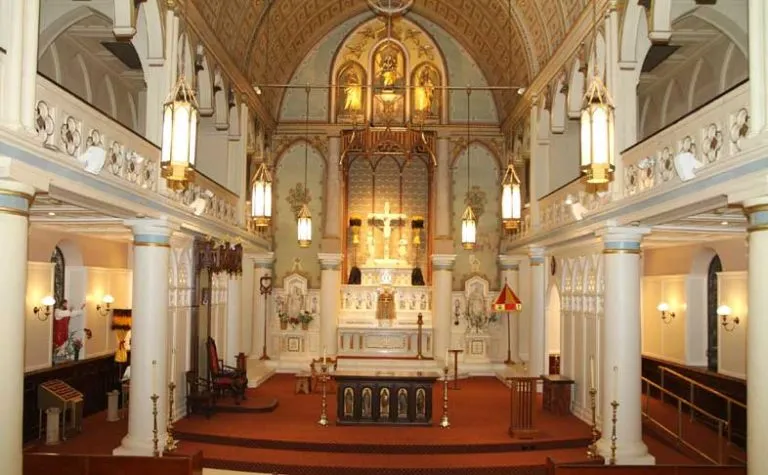
Architectural Styles: Gothic Revival architecture, Romanesque Revival architecture.
The church at 1175 Fort Street Mall is just one building in a larger Cathedral Basilica of Our Lady Peace campus, owned by the Diocese of Honolulu and purchased during the Hawaiian Kingdom Era from Charles Brewer, Charles Reed Bishop, Julius Anthon, Joseph Carter, Alexander Muir, James Makee and Romila Whiting. Much of the land was formerly used as a boarding and day school in the late 1800s – the predecessor institution of Saint Louis School. The campus includes the Chancery building at 1184 Bishop Street, from which the Bishop of Honolulu administers his executive powers as corporation sole. The Chancery also houses the offices of the vicar general and the Hawaiʻi Catholic Herald newspaper. The same high-rise building also houses the rectory, the office and residence of the rector, the parochial vicar and other priests serving the Cathedral Basilica of Our Lady of Peace.
The diocese has leased some of the campus to commercial entities. The Century Square building, a modern skyscraper at 1188 Bishop Street, is rented as office and residential space. Among its tenants is the television studio of KIKU, the local UPN television network affiliate. The parish hall is the “Kamiano Center”, in honor of Father Damien de Veuster.
Changes begun by Sweeney were completed under Joseph Anthony Ferrario, third bishop of Honolulu. Ferrario also inaugurated the beginning phases of ambitious restoration work. His cathedral rectors, Monsignor Terrence A. M. Watanabe and his successor Nathan Mamo, were responsible for sending the clerestory statues of saints perched over the nave of the church back to France where they were professionally preserved. When the statues returned, they were installed above the nave of the church but in a new, more logical order of placement in accordance with the Litany of the Saints.
Francis Xavier DiLorenzo, fourth bishop of Honolulu continued his predecessor’s ambitious renovation projects. Architects were hired to draft plans for an expansion of the Cathedral Basilica of Our Lady of Peace, including the construction of a new chapel using land upon which the famous courtyard statue of Our Lady of Peace now stands. DiLorenzo’s capital improvement projects, administered by his cathedral rectors Gary Secor and later Roland Pacudan, included the replacement of the flooring with stone tiles and installation of new sound systems. Pews and kneelers were restored, also. A traditional baptismal font was replaced with the construction of a large baptismal reflective pool and fountain.
A $13M to 16M campaign to renovate, restore, and renew the Cathedral Basilica was initiated by the current bishop Clarence Silva and Cathedral Basilica rector John Berger around 2010. The overarching theme for the building committee has been to capture the essence of St. Damien de Veuster, restoring the Cathedral Basilica to appearance of the later 1800s.
The “renewal” project also includes installing replica paintings of the Stations of the Cross that were present in the Cathedral Basilica during the time period of St. Damien, new wooden pews and restoring the seating to the ad orientem arrangement, “gas lighting” chandeliers, replacing the pipe organ (the oldest in the state), and landscaping around the roughly 15,000-square-foot building, which sits on about a quarter-acre of land.
There are plans to build a new chapel on the property that will house the relics of both St. Damien de Veuster and St. Marianne Cope, whose mortal remains were enshrined at the Cathedral on July 31, 2014. In addition to the superficial physical changes to the external and internal appearance of the Cathedral Basilica, plans for the restoration include fixing the church foundation, an air conditioning system, controlling possible termite damage again in the future, a sound system, and a lighting system.
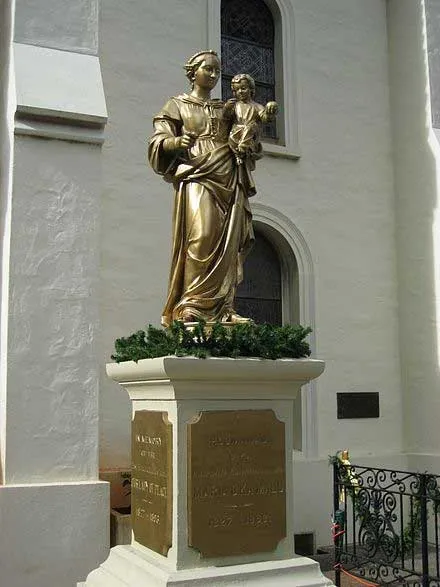
Feast Day – 9th July
The Annual Feast Day of Cathedral Basilica of Our Lady of Peace, Honolulu held on 9th July.
Mass Time
Weekdays
Saturdays
Sundays
Church Visiting Time
Contact Info
1184, Bishop St, Honolulu,
HI 96813, United States
Phone No.
Tel : +1 808-536-7036
Accommodations
How to reach the Cathedral
Daniel K. Inouye International Airport in Honolulu, Hawaii, United States is the nearby Airport to the Cathedral.
Monsarrat Avenue Train Station in Honolulu, Hawaii, United States is the nearby Train Station to the Cathedral.

